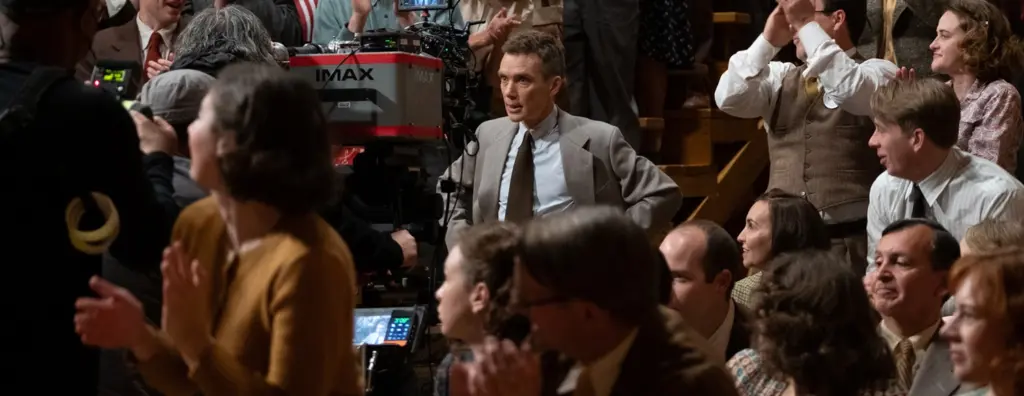IMAX’s technological prowess takes center stage in two highly anticipated movies this summer, Oppenheimer and Mission: Impossible – Dead Reckoning Part One. It’s been said that the star of Mission: Impossible, Tom Cruise, was not happy about Oppenheimer having taken most of the time slots available for the largest format IMAX theaters, but there are compelling emotional and technical reasons for that.


Because, it is Christopher Nolan’s Oppenheimer that promises an experience that is best enjoyed on the largest format IMAX screens. Nevertheless, Universal Pictures has made tickets available for over a thousand premium large format (PLF) screens, including IMAX 70mm, 70mm, IMAX digital, 35mm, Dolby Cinema, and more, while Nolan, in interviews, has talked extensively about how the movie was shot using high-resolution film cameras, employing IMAX 65mm and Panavision 65mm formats.
Nolan is beloved by IMAX because he always uses IMAX cameras, ever since The Dark Knight. The choice to shoot on 65mm and project in 70mm is purely for visual enhancement. In the past, the extra 5mm on the film was reserved for the soundtrack, but with digital sound, this space is no longer necessary.
In Oppenheimer, some sequences are in black and white. Nolan wanted these portions to have the same image quality as the rest of the film, leading to the development of the first-ever black and white IMAX film stock. And, Nolan also has a preference for seating, suggesting that sitting near the front, in the middle of the third row is the best place to experience the movie. For IMAX 1.43:1 screenings, he suggests sitting a little behind the center line, closer to the middle but slightly further back.
The Joy of Film
IMAX 70mm projection and film represents one of the pinnacles of analog film technology, uniquely known for its breathtaking quality and visual immersion. The word IMAX itself is an acronym that stands for “image maximum,” reflecting the technology’s fundamental goal of achieving superior image resolution and size.
At the heart of the IMAX 70mm film technology is the film format itself. Unlike traditional film formats, which are commonly 35mm and are oriented horizontally, IMAX film is 70mm and is oriented vertically. The frames are significantly larger, about 10 times the size of standard 35mm film, and measure 70mm high by 48mm wide. This larger film frame size allows for sharper, more detailed, and less grainy images than what’s achievable with the traditional film format. Consequently, the IMAX 70mm film is ideal for depicting expansive vistas or detailed close-ups with a clarity and resolution that are unsurpassed in traditional film formats. The IMAX film resolution is nearly ten times greater than that of a 35mm projector, delivering exceptional visual detail with approximately 18,000 pixels of resolution per frame compared to the 1,920 pixels of a home HD screen.
Another significant factor in the IMAX experience is the projection technology. IMAX 70mm projectors are unique in their design and complexity. The projectors use a dual xenon lamp system to produce a brighter image necessary for large-format screens. This light source, when coupled with the larger film frame size, allows for the projection of images of unprecedented clarity onto enormous screen sizes.
The IMAX projection system also employs a rolling loop mechanism. As the film runs through the projector, each frame is positioned on a fixed registration point which ensures absolute steadiness when the frame is projected. This mechanism allows the film to be advanced rapidly enough to project the large 70mm frames, while ensuring that the film remains steady and in focus during the projection.
IMAX theaters are typically built with specific architectural design elements that enhance the viewing experience. The screens often span from floor to ceiling and wall to wall, curving slightly towards the audience to create an immersive visual experience. The seating layout is also steeper to ensure an unobstructed view for all viewers, which helps foster the feeling of being ‘in’ the movie rather than merely watching it.
The audio technology in IMAX theatres complements the visual experience. IMAX’s proprietary sound system includes a laser-aligned digital sound system with sub-bass. The speakers are positioned to create a realistic three-dimensional sound field, further contributing to the immersive quality of the IMAX experience.
IMAX 70mm film, coupled with the projection technology and the theatre design, offers an immersive cinematic experience that is hard to match. However, the process of creating IMAX 70mm films is more complex and costly than the process for traditional films, requiring specialized equipment and greater resources. These factors have limited the widespread adoption of the format, but for those films that do utilize it, IMAX 70mm offers an unparalleled experience for the audience.
Despite the increasing prevalence of digital projection systems, the IMAX 70mm film projection still represents a unique offering in the realm of cinema. It stands as a testament to the power and potential of analog film technology. So, maybe Tom Cruise is not happy to have his movie play second fiddle to Nolan’s when it comes to access to the best IMAX screens, but there’s something to be said for an end-to-end experience like the one Nolan promises for Oppenheimer, a deep embedding of an analog technology that we can only hope never disappears.






